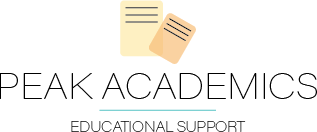As a special educator, the term disabled makes me cringe. When you look up the word disability, you’ll find synonyms such as affliction and defect. Granted, certain things don’t come as easily to my students as they do to other children, but they’re not suffering, and they certainly aren’t defective! To the contrary, while my students access aspects of life in ways different than most others, they also have remarkable abilities that few possess.
Beyond Books: There's More to Your Library Card
How to Create Your Own Habits for Success
A new school year is upon us, and now’s the time to set the tone for a successful year. As with anything, you need to be both mentally and physically prepared in order to make gains. Mentally, you’ll be at a great advantage if you’re cognizant of your learning style. You’ll also benefit from practicing a growth mindset. Beyond that, developing an organizational system that works for you will be key.
STUDENT SPOTLIGHT: WILL D
EXECUTIVE FUNCTION PART 3: PRACTICAL TECHNIQUES TO HELP STUDENTS MOVE FORWARD
In my previous blog about Executive Functioning Skills (EF), I described several strategies suggested by experts. Here I will present some of the approaches I’ve used in my classroom and with students I tutor, which can easily be implemented by parents, teachers, or tutors. These strategies have helped my students demonstrate impulse control, calm their emotions, and persevere through tasks.
STUDENT SPOTLIGHT: JORDAN D
EXECUTIVE FUNCTION PART 2: PUTTING THE PIECES TOGETHER WITH EXPERT STRATEGIES
EXECUTIVE FUNCTION PART 1: AN OVERVIEW
TUTOR SPOTLIGHT: AMY S
STUDENT SPOTLIGHT: EMME M
HELP YOUR CHILD DISCOVER THEIR IDENTITY: FAMILY HERITAGE
TUTOR SPOTLIGHT: DANCHI NGUYEN
MATH IS ALL AROUND US: RESOURCES FOR REAL-LIFE MATH APPLICATIONS
During my time as a middle school math educator, you would not believe the number of times I was asked, “Why do I have to learn this? How is it going to help me in life?” Not that I could turn every math lesson into a life lesson, but these questions reminded me that math is all around us and that the more I can engage students in real-life situations, the more they will enjoy in the learning process and remember the concepts.
STUDENT SPOTLIGHT: MATTHEW A
TIPS FOR A SMOOTH RIDE INTO THE SCHOOL YEAR
TUTOR SPOTLIGHT: BROOKE WILLIAMS
Name: Brooke Williams
Areas of Focus:
My main focus is with students who struggle in academics and/or behavior. I have many strategies that are beneficial to students who struggle with reading, math, focus, and social skills. My background is working with students who have a range of needs such as ADHD, Autism, Gifted, and Dyslexia. I am also Peak's primary evaluator for Comprehensive Educational Evaluations.
SEVEN STRATEGIES FOR SUCCESSFUL SCHOOL TRANSITIONS
STUDENT SPOTLIGHT: JOSH B
STUDENT SPOTLIGHT: BRONWYN MCGARY
TEACHING KIDS TO LOVE SCIENCE
I am a scientist and have spent the better part of my adult life working in a laboratory. When people ask about what that actually means, I usually tell them it’s probably what you imagine—white lab coats, strong smells, things that bubble and change color on the bench top, little cells moving around under a microscope.




















